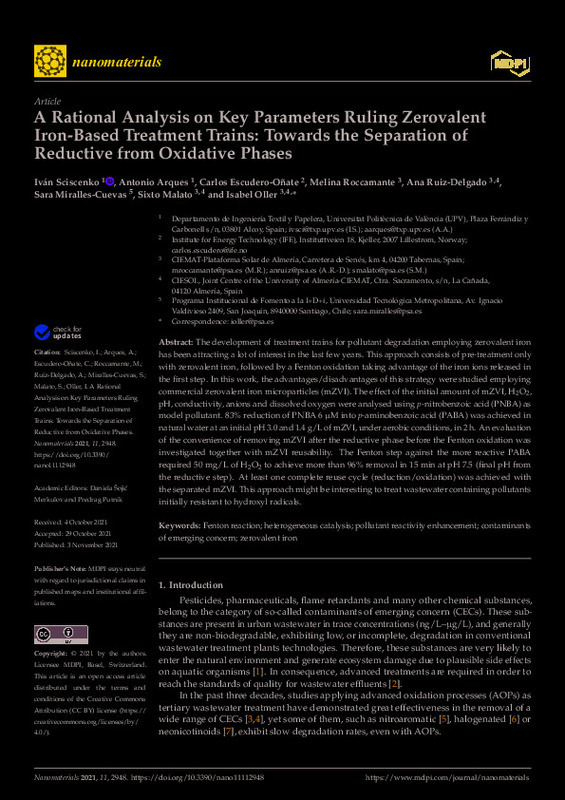JavaScript is disabled for your browser. Some features of this site may not work without it.
Buscar en RiuNet
Listar
Mi cuenta
Estadísticas
Ayuda RiuNet
Admin. UPV
A Rational Analysis on Key Parameters Ruling Zerovalent Iron-Based Treatment Trains: Towards the Separation of Reductive from Oxidative Phases
Mostrar el registro sencillo del ítem
Ficheros en el ítem
| dc.contributor.author | Sciscenko, Iván
|
es_ES |
| dc.contributor.author | Arqués Sanz, Antonio
|
es_ES |
| dc.contributor.author | Escudero-Oñate, Carlos
|
es_ES |
| dc.contributor.author | Roccamante, Melina
|
es_ES |
| dc.contributor.author | Ruiz-Delgado, Ana
|
es_ES |
| dc.contributor.author | Miralles-Cuevas, Sara
|
es_ES |
| dc.contributor.author | Malato, Sixto
|
es_ES |
| dc.contributor.author | Oller, Isabel
|
es_ES |
| dc.date.accessioned | 2022-09-06T18:05:29Z | |
| dc.date.available | 2022-09-06T18:05:29Z | |
| dc.date.issued | 2021-11 | es_ES |
| dc.identifier.uri | http://hdl.handle.net/10251/185442 | |
| dc.description.abstract | [EN] The development of treatment trains for pollutant degradation employing zerovalent iron has been attracting a lot of interest in the last few years. This approach consists of pre-treatment only with zerovalent iron, followed by a Fenton oxidation taking advantage of the iron ions released in the first step. In this work, the advantages/disadvantages of this strategy were studied employing commercial zerovalent iron microparticles (mZVI). The effect of the initial amount of mZVI, H2O2, pH, conductivity, anions and dissolved oxygen were analysed using p-nitrobenzoic acid (PNBA) as model pollutant. 83% reduction of PNBA 6 mu M into p-aminobenzoic acid (PABA) was achieved in natural water at an initial pH 3.0 and 1.4 g/L of mZVI, under aerobic conditions, in 2 h. An evaluation of the convenience of removing mZVI after the reductive phase before the Fenton oxidation was investigated together with mZVI reusability. The Fenton step against the more reactive PABA required 50 mg/L of H2O2 to achieve more than 96% removal in 15 min at pH 7.5 (final pH from the reductive step). At least one complete reuse cycle (reduction/oxidation) was achieved with the separated mZVI. This approach might be interesting to treat wastewater containing pollutants initially resistant to hydroxyl radicals. | es_ES |
| dc.description.sponsorship | This work is part of a project that has received funding from the European Union's Horizon 2020 research and innovation programme under the Marie Sklodowska-Curie grant agreement No. 765860 (AQUAlity). The paper reflects only the authors view and the Agency is not responsible for any use that may be made of the information it contains. | es_ES |
| dc.language | Inglés | es_ES |
| dc.publisher | MDPI AG | es_ES |
| dc.relation.ispartof | Nanomaterials | es_ES |
| dc.rights | Reconocimiento (by) | es_ES |
| dc.subject | Fenton reaction | es_ES |
| dc.subject | Heterogeneous catalysis | es_ES |
| dc.subject | Pollutant reactivity enhancement | es_ES |
| dc.subject | Contaminants of emerging concern | es_ES |
| dc.subject | Zerovalent iron | es_ES |
| dc.subject.classification | QUIMICA FISICA | es_ES |
| dc.subject.classification | INGENIERIA TEXTIL Y PAPELERA | es_ES |
| dc.title | A Rational Analysis on Key Parameters Ruling Zerovalent Iron-Based Treatment Trains: Towards the Separation of Reductive from Oxidative Phases | es_ES |
| dc.type | Artículo | es_ES |
| dc.identifier.doi | 10.3390/nano11112948 | es_ES |
| dc.relation.projectID | info:eu-repo/grantAgreement/EC/H2020/765860/EU | es_ES |
| dc.rights.accessRights | Abierto | es_ES |
| dc.contributor.affiliation | Universitat Politècnica de València. Departamento de Ingeniería Textil y Papelera - Departament d'Enginyeria Tèxtil i Paperera | es_ES |
| dc.description.bibliographicCitation | Sciscenko, I.; Arqués Sanz, A.; Escudero-Oñate, C.; Roccamante, M.; Ruiz-Delgado, A.; Miralles-Cuevas, S.; Malato, S.... (2021). A Rational Analysis on Key Parameters Ruling Zerovalent Iron-Based Treatment Trains: Towards the Separation of Reductive from Oxidative Phases. Nanomaterials. 11(11):1-15. https://doi.org/10.3390/nano11112948 | es_ES |
| dc.description.accrualMethod | S | es_ES |
| dc.relation.publisherversion | https://doi.org/10.3390/nano11112948 | es_ES |
| dc.description.upvformatpinicio | 1 | es_ES |
| dc.description.upvformatpfin | 15 | es_ES |
| dc.type.version | info:eu-repo/semantics/publishedVersion | es_ES |
| dc.description.volume | 11 | es_ES |
| dc.description.issue | 11 | es_ES |
| dc.identifier.eissn | 2079-4991 | es_ES |
| dc.identifier.pmid | 34835712 | es_ES |
| dc.identifier.pmcid | PMC8623565 | es_ES |
| dc.relation.pasarela | S\453969 | es_ES |
| dc.contributor.funder | COMISION DE LAS COMUNIDADES EUROPEA | es_ES |
| dc.subject.ods | 06.- Garantizar la disponibilidad y la gestión sostenible del agua y el saneamiento para todos | es_ES |
| dc.subject.ods | 09.- Desarrollar infraestructuras resilientes, promover la industrialización inclusiva y sostenible, y fomentar la innovación | es_ES |
| dc.subject.ods | 14.- Conservar y utilizar de forma sostenible los océanos, mares y recursos marinos para lograr el desarrollo sostenible | es_ES |
| upv.costeAPC | 1560,23 | es_ES |








